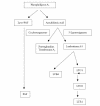Montelukast: its role in the treatment of childhood asthma
- PMID: 18473012
- PMCID: PMC2376066
Montelukast: its role in the treatment of childhood asthma
Abstract
The cysteinyl leukotrienes, LTC(4), LTD(4), and LTE(4), play an integral role in the pathophysiology of asthma. Acting via the type 1 leukotriene (CysLT(1)) receptor, these proinflammatory mediators have numerous effects in the lungs, including decreased activity of respiratory cilia, increased mucus secretion, increased venopermeability, and promotion of eosinophil migration into airway mucosa. Blocking studies show that Cys-LTs are pivotal mediators in the pathophysiology of asthma. Cys-LTs are key components in the early and late allergic airway response and also contribute to bronchial obstruction after exercise and hyperventilation of cold, dry air in asthmatics. Effects of the cysteinyl leukotrienes are blocked by leukotriene receptor antagonists; these agents inhibit bronchoconstriction in normal subjects provoked with inhaled cysteinyl leukotrienes, as well as in patients with asthma undergoing allergen, exercise, cold air, or aspirin challenge. Montelukast is a potent and selective blocker of the CysLT(1) receptor. For treatment of chronic asthma, montelukast is administered once daily to adults as a 10-mg film-coated tablet, to children aged 6-14 years as a 5-mg chewable tablet, and to children aged 2-5 years as a 4-mg chewable tablet form. Given their efficacy, antiinflammatory activity, oral administration, and safety, leukotriene modifiers will play an important role in the treatment of asthmatic children.
Keywords: asthma; children; efficacy; montelukast.
Figures
References
-
- Anderson SD. Single-dose agents in the prevention of exercise-induced asthma: a descriptive review. Treat Respir Med. 2004;3:365–79. - PubMed
-
- Altman LC, Munk Z, Seltzer J. A placebo-controlled, dose-ranging study of montelukast, a cysteinyl leukotriene-receptor antagonist. J Allergy Clin Immunol. 1998;102:50–6. - PubMed
-
- Becker A, Swern A, Tozzi CA, et al. Montelukast in asthmatic patients 6 years-14 years old with an FEV1 > 75% Curr Med Res Opin. 2004;20:1651–9. - PubMed
-
- Bisgaard H. Leukotriene modifiers in pediatric asthma management. Pediatrics. 2001;107:381–90. - PubMed
-
- Bisgaard H, Loland L, Oj JA. No in exhaled air asthmatic children is reduced by the leukotriene receptor antagonist montelukast. Am J Respir Crit Care Med. 1999;160:1227–31. - PubMed
LinkOut - more resources
Full Text Sources



